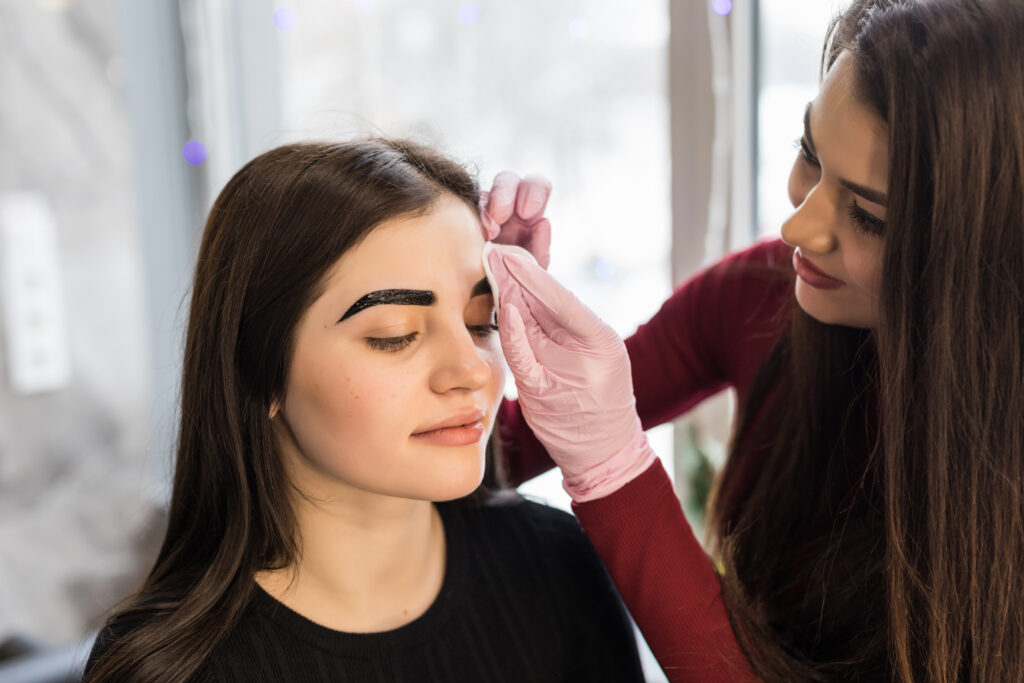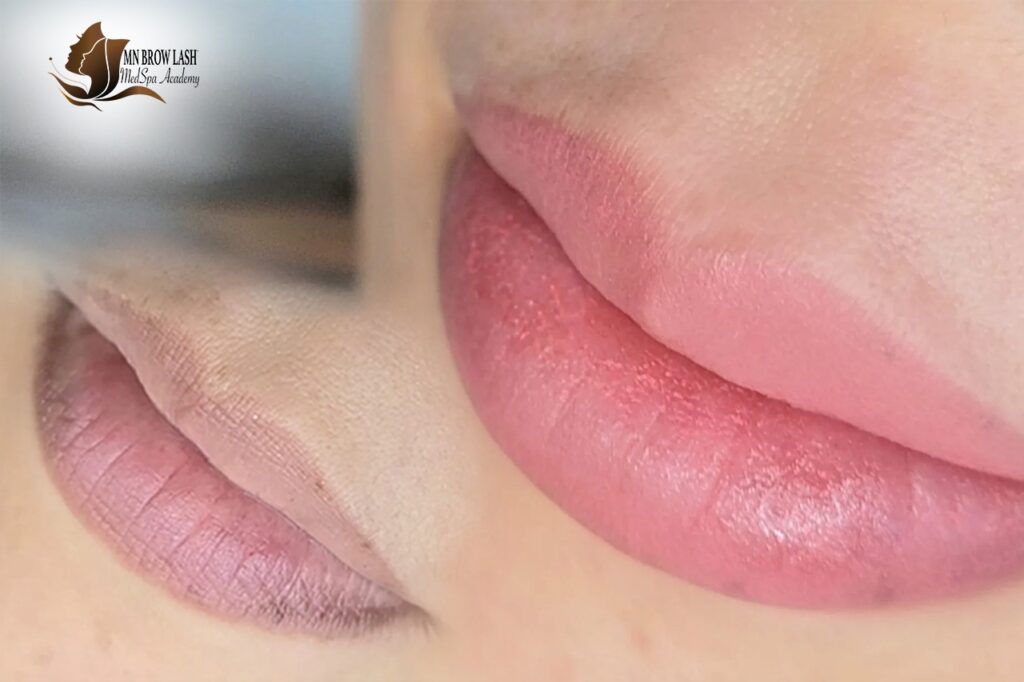Have Questions? Contact Us Now!
- By whitebunniegpa
The Difference Between Microblading, Machine Hairstrokes, and Powder Brows
When it comes to enhancing your eyebrows, several options are available, each offering different techniques and results. The three most popular methods in permanent makeup are microblading, machine hairstrokes, and powder brows. While all three aim to create fuller, more defined brows, they differ in how the pigment is applied, the final look, and the ideal candidates for each technique. Understanding the differences can help you decide which method best suits your needs or, if you’re a PMU student, which technique to specialize in.
In this article, we’ll explain each method, how they work, and what kind of results you can expect.
What Is Microblading?
Microblading is a semi-permanent technique that uses a handheld tool to create individual strokes that mimic natural eyebrow hairs. The tool has tiny blades that cut the skin’s surface and deposit pigment into the upper layers. Each stroke is carefully placed to replicate the look of natural brow hairs, giving the brows a fuller, more defined appearance.
Microblading is best suited for:
- People with normal to dry skin, as oily skin can cause the pigment to blur or fade more quickly.
- Those looking for a natural, hairlike appearance with fine, crisp strokes.
- Individuals who want a semi-permanent solution, as microblading typically lasts 1218 months before needing a touchup.
Pros of Microblading:
- The strokes are very fine and realistic, making it an excellent option for those who want a natural look.
- Minimal healing time compared to other methods.
- It’s a relatively quick procedure, usually completed in about two hours.
Cons of Microblading:
- Not ideal for oily skin, as the pigment can fade faster or blur.
- Requires touchups more frequently than other methods.
- Can cause more irritation and skin trauma because it involves cutting the skin.
What Are Machine Hairstrokes?
Machine hair strokes, also known as nano hair strokes, involve using a machine with a fine needle to create individual, hairlike strokes. Unlike microblading, where the pigment is manually inserted, the machine deposits pigment more consistently and with less trauma to the skin. This method allows for more precision, making it a great option for clients looking for ultrafine, realistic strokes.
The machine method can also reach deeper layers of the skin, meaning that machine hair strokes tend to last longer than microblading, often requiring fewer touchups over time.
Machine hair strokes are best suited for:
- For clients with oily or combination skin, the machine can provide more stable, long-lasting results.
- Those looking for a more natural, long-lasting solution with fine, realistic strokes.
- Anyone who prefers a machine-applied technique for more precision and control.
Pros of Machine Hairstrokes:
- Suitable for a wider range of skin types, including oily skin.
- Longer lasting results compared to microblading, often lasting up to two years before requiring touchups.
- Less trauma to the skin, resulting in faster healing and reduced scabbing.
Cons of Machine Hairstrokes:
- The procedure can take longer, especially for beginners learning the technique.
- More specialized training and practice are required to perfect the strokes using a machine.

What Are Powder Brows?
Powder brows is a technique that involves shading the entire brow area with a gradient effect, starting lighter at the front of the brows and getting darker towards the tail. This technique is performed using a machine, and instead of creating individual hairlike strokes, the pigment is applied in a soft, powdery manner that gives the appearance of a fuller, more defined brow.
Unlike microblading and machine hair strokes, which aim for a natural hairlike look, powder brows create a bolder, more filled-in appearance, similar to the effect of wearing eyebrow makeup.
Powder brows are best suited for:
- Clients who want a bolder, more defined brow that mimics the look of makeup.
- For people with oily or mature skin, as the shading technique works well on these skin types and tends to fade less.
- Those who prefer a longerlasting solution, as powder brows can last up to three years before needing a touchup.
Pros of Powder Brows:
- Ideal for clients who want a more defined, makeuplike look.
- Suitable for all skin types, including oily skin.
- Less chance of blurring or fading over time compared to microblading.
Cons of Powder Brows:
- The result is not as natural or hairlike as microblading or machine hairstrokes, so it may not be ideal for clients seeking a very natural look.
- Healing can take longer due to the shading technique covering a larger area of the brow.
Powder Brows vs. Microblading: Which Is Better?
Choosing between powder brows vs. microblading comes down to the kind of look your client is aiming for. If a more natural, hairlike brow is desired, microblading may be the better option. However, if they prefer a defined, powdery look that mimics the effect of makeup, powder brows might be the way to go.
For clients who like a softer blend and don’t want a harsh makeup look, ombre powder brows vs. microblading is another consideration. Ombre powder brows create a gradient look, with a softer color at the front of the brows and more definition at the tail, providing a happy medium between the two techniques.

How to Choose the Best Brows Techniques for Your Clients
When it comes to choosing the best brows techniques, there are several factors to consider. The skin type, desired outcome, and client preferences all play a role in determining whether powder brows, machine hairstrokes, or microblading will deliver the best results.
- Microblading is perfect for clients looking for a natural, hairlike look and who have normal to dry skin. However, it requires more frequent touchups and isn’t ideal for oily skin types.
- Machine hairstrokes offer a longerlasting solution with finer, more realistic strokes and work well for all skin types, especially oily skin. This method is also less traumatic for the skin, allowing for faster healing.
- Powder brows are ideal for clients who want a more defined, makeuplike appearance with longlasting results. The soft, gradient effect works especially well for clients with oily or mature skin.
For PMU students, mastering all three techniques can open up opportunities to expand your services and cater to a wider range of clients.
Powder Brows vs. Machine Hairstrokes
When comparing powder brows vs. machine hairstrokes, it’s important to consider the desired outcome. Powder brows give a more solid, filledin appearance, while machine hairstrokes mimic individual hairs for a more natural look. Clients who want a bold, dramatic brow may prefer powder brows, while those seeking a subtle, realistic appearance may opt for machine hairstrokes.
Frequently Asked Questions (FAQs)
Can I combine machine hairstrokes with powder brows?
Yes, many artists offer a combination of machine hairstrokes and powder brows, sometimes called a hybrid technique. This combines the fine hairlike strokes of nano hairstrokes with the shaded effect of powder brows to create a natural yet defined look.
How long does each technique last?
Microblading typically lasts 1218 months, depending on skin type and care.
Machine hairstrokes last up to two years, with fewer touchups required.
Powder brows can last up to three years, making them the longestlasting option.
Is one technique more painful than the others?
Pain levels vary depending on individual tolerance and the method used. Most clients report that machine hairstrokes are less painful than microblading due to the reduced trauma to the skin. Powder brows may cause mild discomfort but are generally welltolerated with numbing cream.




